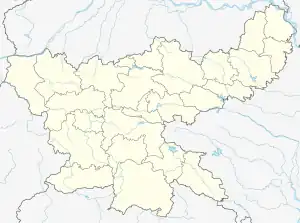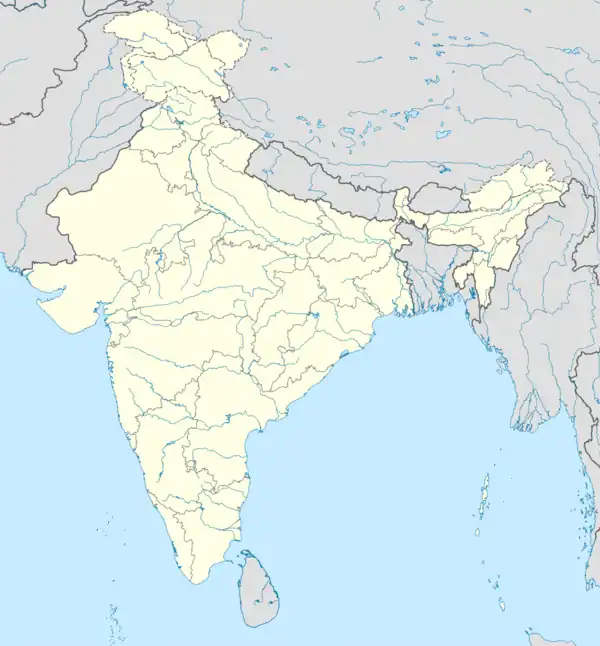Rahe block
Rahe is a community development block (CD block) that forms an administrative division in the Bundu subdivision of the Ranchi district, Jharkhand state, India.
Rahe | |
|---|---|
Community development block | |
 Rahe Location in Jharkhand, India  Rahe Rahe (India) | |
| Coordinates: 23.2654°N 85.6447°E | |
| Country | |
| State | Jharkhand |
| District | Ranchi |
| Government | |
| • Type | Federal democracy |
| Area | |
| • Total | 180.42 km2 (69.66 sq mi) |
| Population (2011) | |
| • Total | 53,916 |
| • Density | 300/km2 (770/sq mi) |
| Languages | |
| • Official | Hindi, Urdu |
| Time zone | UTC+5:30 (IST) |
| PIN | 835204 |
| Telephone/STD code | 0651 |
| Literacy | 65.19% |
| Lok Sabha constituency | Ranchi |
| Vidhan Sabha constituency | Silli |
| Website | ranchi |
Maoist activities, dissent
Jharkhand is one of the states affected by Maoist activities. As of 2012, Ranchi district was among the highly affected districts in the state.[1] “Areas of Tamar, Bundu, Sonahatu, Angarha, Sikidari Police Stations and Rahe O.P. have been widely affected by activities of CPI (Maoist) group till the end of year 2009. At the end of year 2010, The activities of CPI (Maoist) group has been minimized up to almost zero level.”[2]
According to the Jharkhand Police spokesperson and Inspector General (IG) Saket Singh, as reported on December 8, 2020, “The activities of CPI-Maoist are now confined to small pockets in the state because of our efforts.” Civilian fatalities, a key index of security in a region, declined from 20 in 2019, to 8 in 2020, the lowest in this category since 2000, when there were 13 such fatalities. The 28 total fatalities recorded in 2020 are also the lowest overall fatalities recorded in the state in a year since 2000, when they stood at 36.[3]
Ranchi being the capital city of the state has always been under minute scrutiny of all.[4] The arrest, from his home in Ranchi on October 9, 2020, by the NIA, of 83-years old Rev. Fr. Stan Swamy, S.J., Jesuit priest and activist, working with tribals for decades, and his subsequent death in custody, in a Mumbai hospital, on 5 July 2021, has been widely discussed.[5][6][7][8]
Geography
Rahe is located at 23.2654°N 85.6447°E.
Rahe CD block is located on the Lower Chota Nagpur Plateau. It has an average elevation of 500–1,000 feet (150–300 m) above mean sea level.[9]
Rahe CD block is bounded by the Angara CD block on the north, Silli and Sonahatu CD blocks on the east, Bundu on the south and Namkum CD block on the west.[10]
Rahe CD block has an area of 180.42 km2.[11] There is a police outpost at Rahe.[12] The headquarters of Rahe CD block is located at Rahe village.[13]
Demographics
Population
According to the 2011 Census of India, Rahe CD block had a total population of 53,916, all of which were rural. There were 27,334 (51%) males and 26,582 (49%) females. Population in the age range 0–6 years was 7,532. Scheduled Castes numbered 3,502 (6.50%) and Scheduled Tribes numbered 17,311 (32.11%).[11]
The percentage of Scheduled Tribes in Ranchi district, in 2011, was 47.67% of the population (rural) in the blocks.[14] The percentage of Scheduled Tribes, numbering 1,042,016, in the total population of Ranchi district numbering 2,914,253 in 2011, was 35.76%. The Oraons forming 18.20% of the population and the Mundas forming 10.30% of the population, were the main tribes. Other tribes included (percentage of population in brackets) Lohra (2.46), Bedia (1.32) and Mahli (1.09).[15]
Literacy
As of 2011 census, the total number of literate persons in Rahe CD block was 32,094 (69.19% of the population over 6 years) out of which males numbered 19,481 (83.02% of the male population over 6 years) and females numbered 12,613 (55.03% of the female population over 6 years). The gender disparity (the difference between female and male literacy rates) was 27.99%.[11]
As of 2011 census, literacy in Ranchi district was 77.13%. Literacy in Jharkhand was 67.63% in 2011.[16] Literacy in India in 2011 was 74.04%.[17]
See also – List of Jharkhand districts ranked by literacy rate
| Literacy in CD Blocks of Ranchi district |
|---|
| Ranchi Sadar subdivision |
| Burmu – 64.54% |
| Khelari – 74.83% |
| Kanke – 73.75% |
| Ormanjhi – 67.53% |
| Silli – 73.73% |
| Angara – 64.92% |
| Namkum – 73.72% |
| Ratu – 73.00% |
| Nagri – 71.59% |
| Mandar – 67.63% |
| Chanho – 66.81% |
| Bero – 67.49% |
| Itki – 73.58% |
| Lapung – 60.29% |
| Bundu subdivision |
| Rahe – 69.19% |
| Bundu – 66.38% |
| Sonahatu – 66.04% |
| Tamar – 62.76% |
| Source: 2011 Census: CD block Wise Primary Census Abstract Data |
Rural poverty
60-70% of the population of Ranchi district were in the BPL category in 2004–2005.[21] In 2011–12, the proportion of BPL population in Ranchi district came down to 27.82%.[22] According to a study in 2013 (modified in 2019), "the incidence of poverty in Jharkhand is estimated at 46%, but 60% of the scheduled castes and scheduled tribes are still below poverty line."[23]
Economy
Livelihood
Livelihood
in Rahe CD block
In Rahe CD block in 2011, amongst the class of total workers, cultivators numbered 9,496 and formed 35.11%, agricultural labourers numbered 13,663 and formed 50.52%, household industry workers numbered 1,184 and formed 4.38% and other workers numbered 2,703 and formed 9.99%. Total workers numbered 27,046 and formed 50.16% of the total population, and non-workers numbered 26,870 and formed 49.84% of the population.[24]
Infrastructure
There are 59 inhabited villages in Rahe CD block. In 2011, 3 villages had power supply. 59 villages had well water (covered/ uncovered), 59 villages had hand pumps, and all villages have drinking water facility. 1 village had sub post office, 18 villages had mobile phone coverage. 49 villages had pucca (paved) village roads. 2 villages had taxi/vans, 5 villages had tractors. 3 villages had bank branches. 2 villages had public distribution system, 51 villages had assembly polling stations.[25]
Agriculture
In Ranchi district, 23% of the total area is covered with forests. “With the gradual deforestation of the district, more and more land is being brought under cultivation.” Terraced low lands are called don and the uplands are called tanr. The hill streams remain almost dry, except in the rainy season, and does not offer much scope for irrigation.[26]
In Rahe CD block, 53.53% of the total area was cultivable, in 2011. Out of this, 4.32% was irrigated land.[27]
Backward Regions Grant Fund
Ranchi district is listed as a backward region and receives financial support from the Backward Regions Grant Fund. The fund, created by the Government of India, is designed to redress regional imbalances in development. As of 2012, 272 districts across the country were listed under this scheme. The list includes 21 districts of Jharkhand.[28][29]
Education
Rahe CD block had 3 villages with pre-primary schools, 56 villages with primary schools, 23 villages with middle schools, 4 villages with secondary schools, 6 villages with senior secondary schools, 3 villages with no educational facility.[30]
.*Senior secondary schools are also known as Inter colleges in Jharkhand
Healthcare
Rahe CD block had 1 village with primary health centre, 5 villages with primary health subcentres, 1 village with maternity and child welfare centre, 1 village with maternity hospital.[30]
.*Private medical practitioners, alternative medicine etc. not included
References
- "Jharkhand Assessment 2013". Satp. Retrieved 4 September 2021.
- "District Police Profile Ranchi". Crime Trends – Specially Organised Crime Rural Area. Jharkhand Police. Retrieved 4 September 2021.
- "Jharkhand: Dying Embers". India Blooms. Retrieved 4 September 2021.
- "District Police Profile - Ranchi". SP’s message and vision. Jharkhand Police. Retrieved 4 September 2021.
- "NIA court to pass order on Stan Swamy bail on March 22". The Hindu. 16 March 2021 – via www.thehindu.com.
- Regi, Anjali (9 October 2020). "Fr. Stan Swamy arrested: Widespread protest". Catholic Focus. Retrieved 11 October 2020.
- "Elgar Parishad Case: Activist Stan Swamy, 84, Passes Away Ahead of Hearing on Bail Plea". News18. 5 July 2021. Retrieved 5 July 2021.
- "'Distressed, troubled': Ranchi Catholic Church issues statement on Stan Swamy's arrest, demands his release". The Indian Express, 9 October 2020. Retrieved 4 September 2021.
- "District Census Handbook Ranchi, Series 21 Part XII A, Census of India 2011" (PDF). Page 9: Administrative Setup, Page 10: Physiography. Directorate of Census Operations, Jharkhand. Retrieved 28 August 2021.
- "Ranchi CD block/ Tehsil map". Maps of India. Retrieved 28 August 2021.
- "District Census Handbook, Ranchi, Series 21, Part XII B" (PDF). Page 28: District primary census abstract, 2011 census. Directorate of Census Operations Jharkhand. Retrieved 28 August 2021.
- "District Police Profile - Ranchi". Jharkhand Police. Retrieved 28 August 2021.
- "District Census Handbook, Ranchi, Series 21, Part XII A" (PDF). Map of Ranchi district on the third page. Directorate of Census Operations Jharkhand. Retrieved 28 August 2021.
- "District Census Handbook, Ranchi, Series 21, Part XII A" (PDF). Page 56, Table 14: Number and percentage of scheduled castes and scheduled tribes (rural) population in CD Blocks, 2011. Directorate of Census Operations Jharkhand. Retrieved 28 August 2021.
- "District Census Handbook, Ranchi, Series 21, Part XII A" (PDF). Pages 39-40: Scheduled Castes and Scheduled Tribes of Cenus 2011. Directorate of Census Operations Jharkhand. Retrieved 28 August 2021.
- "Provisional Population Totals Paper 1 of 2011: Jharkhand". Sr. No. 5, Sheet 2. Registrar General and Census Commissioner, Government of India. Retrieved 28 August 2021.
- "Ranking of states and union territories by literacy rate: 2011" (PDF). Page 110. Government of India. Retrieved 28 August 2021.
- "Table C-01 Population By Religion - Jharkhand". census.gov.in. Registrar General and Census Commissioner of India.
- "Report of the Commissioner for linguistic minorities: 50th report (July 2012 to June 2013)" (PDF). Commissioner for Linguistic Minorities, Ministry of Minority Affairs, Government of India. p. 35. Archived from the original (PDF) on 8 July 2016. Retrieved 28 August 2021.
- "Table C-16 Population by Mother Tongue: Jharkhand". censusindia.gov.in. Registrar General and Census Commissioner of India.
- "Rural Poverty in Jharkhand, India" (PDF). Table I: Spatial Distribution of Poverty in Jharkhand. Munich Personal RePEc Archive. Retrieved 1 September 2021.
- "Spatial poverty in Jharkhand". Mint. Retrieved 1 September 2021.
- "Rural Poverty in Jharkhand, India: An Empirical Study based on Panel Data". MPRA. Retrieved 1 September 2021.
- "District Census Handbook 2011 Ranchi, Series 21, Part XII A" (PDF). Tables 30 and 33, pages 67 and 71. Directorate of Census Operations, Jharkhand. Retrieved 1 September 2021.
- "District Census Handbook, Ranchi, 2011, Series 21, Part XII A" (PDF). Pages 595-598, Appendix I: Village Directory. Directorate of Census Operations, Jharkhand. Retrieved 2 September 2021.
- "District Census Handbook, Ranchi, 2011, Series 21, Part XII A" (PDF). Page 11:Forestry and Flora and Fauna, Page12: Soil and Cropping, Land and Land use pattern, tenancy and agriculture, Page 13: Irrigation. Directorate of Census Operations, Jharkhand. Retrieved 2 September 2021.
- "District Census Handbook, Ranchi, 2011, Series 21, Part XII A" (PDF). Page 84, Table 41: Distribution of villages according to land use. Directorate of Census Operations, Jharkhand. Retrieved 2 September 2021.
- "Backward Regions Grant Funds: Programme Guidelines" (PDF). Ministry of Panchayati Raj, Government of India. Archived from the original (PDF) on 30 October 2017. Retrieved 3 September 2021.
- "Backward Regions Grant Fund". Press Release, 14 June 2012. Press Information Bureau, Government of India. Retrieved 3 September 2021.
- "District Census Handbook Ranchi, 2011, Series 21, Part XII A" (PDF). Pages 595-596. Directorate of Census Operations, Jharkhand. Retrieved 3 September 2021.